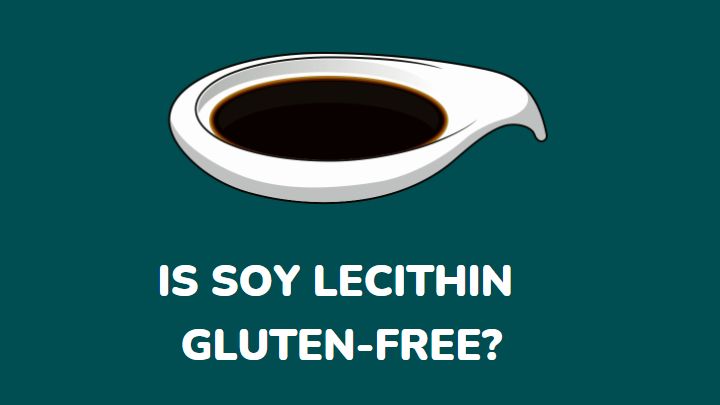Soy lecithin is made from soybeans, which is a gluten-free grain. However, you should know that gluten gets into foods through other ingredients like additives. So, is soy lecithin 100% gluten-free?
Just so you know, gluten is a protein that masks under different names. While some foods are naturally gluten-free, it is possible that while processing them into something else, gluten gets into the picture.
This is why people who practice a gluten-free diet must thoroughly investigate every ingredient in their food.
What is soy lecithin?
Soy lecithin is an ingredient as common as sugar and flour. It is an additive present in many processed and packaged foods. Soy lecithin is a soy derivative that acts as an emulsifier to bind food that contains water and oil.
This soy derivative in processed foods is the ingredient that makes oil-based and water-based ingredients mix well and uniformly.
Soy lecithin also works as an antioxidant and helps to protect the flavor of processed foods. Moreover, it is safe for consumption and can help lower high cholesterol levels.
Is soy lecithin gluten-free?
Yes, soy lecithin is gluten-free.
The US Food and Drug Administration (FDA) confirms that it is not a derivative of wheat, rye, or barley which are gluten-rich foods.
Furthermore, this lecithin is a product of processing soy oil, which is extracted from raw soybeans. The lecithin is then dried and used as an additive in processed foods and medicines.
In addition, soy lecithin contains soy protein, choline, glycerol, choline, fatty acids, triglycerides, phospholipids, glycolipids, and phosphoric acid.
Is soy lecithin gluten-free and dairy-free?
Yes, it is.
Soy lecithin is purely plant-based and has no trace of dairy or animal by-products in it. It is therefore considered safe for people practicing a dairy-free diet.
Why do you need soy lecithin in your diet?
No soy allergies
With soy lecithin, you don’t have to worry about soy allergies. The amount of soy protein residues in this lecithin is not sufficient to trigger an allergic reaction.
It reduces cholesterol levels
Soy lecithin targets and reduces Low-Density Lipoprotein (LDL), the bad cholesterol, while it increases High-Density Lipoprotein (HDL), the good cholesterol.
It, therefore, reduces the risk of having cardiovascular diseases, which are a result of the build-up of fat in the wall of the arteries.
Good for lactating mothers
It is good for nursing mothers to consume foods that are rich in soy lecithin. It helps clear clogged ducts which affect the rate of breast milk flow. Clogged ducts also affect the mother and make breastfeeding a painful experience.
Moreover, taking soy lecithin for clogged ducts will help prevent the progression of these clogged ducts into an infection.
Brain boost
Soy lecithin improves cognitive function. It provides the body with choline, an essential nutrient necessary for neurotransmission.
This can help reduce the risk of organ dysfunction and muscle damage. Therefore, soy lecithin is good for brain development and improved memory.
Enhances digestion
Soy lecithin aids in proper digestion. It is also good for people with Inflammatory Bowel Disease (IBD) like ulcerative colitis. Eating soy lecithin in their diet can help improve digestive issues that IBD causes.
Improved immunity
People who have diabetes are advised to consume foods that contain soy lecithin. This is because it can help increase their immune system by increasing the activities of the white blood cell by 29%.
What can you do with soy lecithin?
- Make homemade bread
- Add soy lecithin to vegan butter
- Add it to homemade biscuits and cookies
- Soy lecithin is good for salad dressing
- Add soy lecithin to your beverages to make them frothy and for a nutrients boost
- Soy lecithin is a good additive in vegan ice-creams
- Homemade chocolate
- Use soy lecithin to thicken water-based soups and sauces
How much soy lecithin should you use?
Generally, the daily intake of soy lecithin should not go beyond 5,000 mg. When using soy lecithin in the kitchen, you can follow this guide to keep your lecithin intake in check.
- Add 1 teaspoon of soy lecithin to every 1 cup of flour when baking
- 1 teaspoon of soy lecithin for every 1 cup of liquid- milk, butter, or oil
- To replace eggs, add 1 tablespoon of soy lecithin to replace one egg
- For soups and sauces, use ½ teaspoon of soy lecithin
- To add froth to your beverages, 1g of soy lecithin per 100g of liquid
- For salad dressing, whisk ½ teaspoon of soy lecithin with every ½ cup of oil
Are there side effects of consuming soy lecithin?
Although considered safe for consumption, soy lecithin may cause side effects like abdominal bloating and pain, reduced appetite, excessive sweating, increased salivation, and nausea.
FAQs
Is soy lecithin safe for people with soy allergies?
Yes, it is.
The soy protein residues present in soy lecithin cannot cause soy allergy. This is because soy lecithin loses most of the soy protein during processing.
What can you use instead of soy lecithin?
Egg yolks, honey, sunflower lecithin, and mustard are liquid gluten-free substitutes for soy lecithin. You can use xanthan gum or agar-agar as alternatives for powdered soy lecithin.
Can vegans eat soy lecithin?
Vegans can safely eat soy lecithin because it is purely plant-based and contains no animal by-products.
Conclusion
A gluten-free diet is a very cautious one. Gluten doesn’t provide the body with any essential nutrients. It rather causes side effects like bloating, constipation, diarrhea, and fatigue. This is one of the reasons why people are encouraged to scrap gluten.
If you practice this diet, you certainly want to know the gluten status of every ingredient in your food. Soy lecithin, the focus of this article, is gluten-free.
Thanks for reading.
I hope you found this article resourceful. If you did, you should also see this comparison of soya vs soy.

